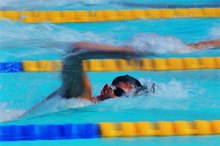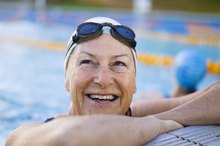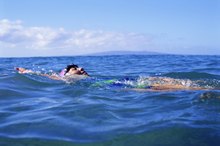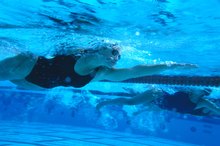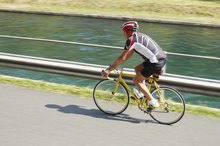Calories Burned in Swimming vs. Aqua Jogging
Swimming and aqua jogging are viable options if you're looking for exercises that are easy on the joints. Swimming, whether you're doing leisurely laps or training for a competition stroke such as backstroke, breaststroke, butterfly or freestyle, requires more expertise than aqua aerobics, like aqua jogging, and burns more calories per hour as well 1.
Competitive Swimming
The four strokes used in competitive swimming -- backstroke, breaststroke, butterfly and freestyle -- burn more calories than noncompetition strokes like the sidestroke 1. Of the four competition strokes, butterfly burns the most calories. The average 135-pound swimmer burns 649 calories per hour doing this stroke, compared to 413 calories an hour doing the backstroke. The more you weigh, the more you'll burn. A 205-pound swimmer burns 1,024 calories an hour doing the butterfly and 651 calories an hour with the backstroke.
- The four strokes used in competitive swimming -- backstroke, breaststroke, butterfly and freestyle -- burn more calories than noncompetition strokes like the sidestroke 1.
- The average 135-pound swimmer burns 649 calories per hour doing this stroke, compared to 413 calories an hour doing the backstroke.
Noncompetitive Swimming
How to Tread Water for Weight Loss
Learn More
Your body burns hundreds of calories an hour swimming even if you're not training for competition, whether you're doing one of the four competition strokes, though at a slower pace, or performing another stroke like the sidestroke 1. A 135-pound individual swimming leisurely freestyle laps burns about 413 calories an hour 1. A person of the same weight swimming casually, without doing a specified stroke, burns about 354 calories an hour 1. A 135-pound swimmer burns approximately 472 calories an hour doing the sidestroke.
Aqua Jogging
Aqua jogging is done by jogging in the water. Your body is vertical, with your chest, torso and lower body underwater and your shoulders, neck and head out of it. Some aqua joggers choose to wear a flotation belt around the waist, but this is not required. The legs do a jogging motion under the surface. To avoid touching the bottom of the pool, which can interrupt the jogging motion, it should be done in deeper water. The arms either remain still or move in a jogging motion. A 135-pound person burn 472 calories in an hour of aqua jogging and a 205-pound individual burns 745.
- Aqua jogging is done by jogging in the water.
- To avoid touching the bottom of the pool, which can interrupt the jogging motion, it should be done in deeper water.
Treading Water
Can You Swim Post ACL Surgery?
Learn More
Treading water shares many similarities with aqua jogging. While you won't wear a flotation belt, your body will be in the same vertical position with only your shoulders, neck and head out of the water. Arms move in a sculling motion, opening then closing at chest level along the water's surface, while the legs can do breaststroke kick, dolphin kick, flutter kick, eggbeater kick or a scissors kick. The average 135-pound swimmer burns 236 calories an hour treading water at a leisurely pace, while increasing the intensity to a fast pace burns about 590 calories an hour.
- Treading water shares many similarities with aqua jogging.
- Arms move in a sculling motion, opening then closing at chest level along the water's surface, while the legs can do breaststroke kick, dolphin kick, flutter kick, eggbeater kick or a scissors kick.
Related Articles
References
Writer Bio
Elizabeth Falwell has been writing for the TV news industry since 2005. Her work has appeared on WXII 12 News, WMGT 41 News, NewParent.com and multiple parenting blogs. A graduate of the S.I. Newhouse School at Syracuse University, Falwell holds a Master of Science in broadcast journalism.

